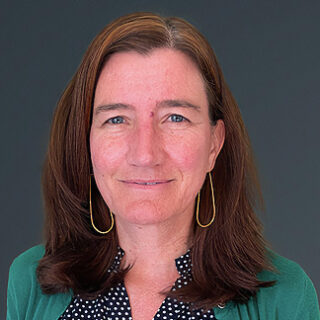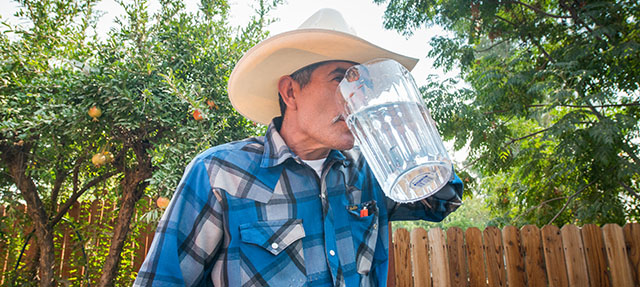As the state of California seeks to fix its crumbling water infrastructure, the State Water Board has embarked on an ambitious program to encourage struggling small water systems to join forces with larger, neighboring water systems. We spoke with the State Water Board’s Michelle Frederick and clean-water advocacy group Community Water Center’s Ryan Jensen about why consolidation is important, how efforts are going, and what could be improved.
First of all, what are the benefits of consolidation, and what problem is it supposed to address?
Michelle Frederick: We have about 2,900 community water systems that serve homes and businesses in California. Half of these systems have fewer than 100 connections. They suffer from limited staffing, they’re run by volunteer boards, and their rates don’t cover long-term improvements. They struggle to cope with things like drought or contaminated drinking water. Rather than put Band-Aids on these problems, we want to find a sustainable solution. In 2019, the Safe and Affordable Drinking Water Fund allocated approximately $1.3 billion dollars to help struggling water systems, and it emphasizes sustainable solutions such as consolidation.
Ryan Jensen: Your access to safe drinking water should not be determined by your address. A legacy of racial or socioeconomic discriminatory policies pushed some communities to the margins. Consolidation is a way to right the historical marginalization process.
How are we doing with consolidations in California?
MF: Overall I think we’re doing well, but there’s still room for improvement. People are afraid of what consolidation might mean, but we’ve done 178 consolidations since 2016, and that helps alleviate some concerns. We’re working on another 175 consolidation projects right now; since June, we’ve held nine water partnership workshops and sent out 600 letters recommending that water systems near bigger ones look into consolidation. We are pushing against many historical practices, so it takes a little while to right a whole ship. When consolidations start happening on their own, then we’ll know we’ve succeeded.
RJ: The State Water Board has a lot of new tools, but it’s still figuring out how to use them effectively. The easier consolidations have happened. How does the board fund and support districts where there’s willingness to consolidate but little capacity? How do you support more difficult consolidations? There’s a lot of misinformation about consolidations; sometimes you’re trying to change hearts and minds.
MF: Our SAFER program now puts a heavy emphasis on public participation. The State Water Board has a new Office of Public Participation and additional drinking water staff dedicated to engagement. Board staff work closely with communities to answer their questions, dispel misinformation, and bring them into the process.
What issues have you encountered?
RJ: When small water systems don’t have safe drinking water, that’s a failure of representative governance. One barrier is whether a bigger water system will be willing to sit down with a small system. In Tooleville, there was a concerted effort to consolidate with the City of Exeter, and Exeter shut down negotiations. The same thing happened in East Orosi. The larger system may feel the need to protect its existing customers, but a lot of customers would likely say, “If we could provide safe drinking water to our neighbors and cousins in East Orosi without hurting our system, why aren’t we doing that?”
MF: Although the State Water Board can now fund a significant share of consolidation costs—up to 100% for disadvantaged communities—larger systems are concerned about who will pay for long-term operation and maintenance costs once the project is done. The State Water Board is creating additional financial incentives for larger systems to encourage their participation. Cities can now get $10 million loans, interest-free, for their own infrastructure projects. We’ve also added $5,000 in grants per connection for disadvantaged communities, and $10,000 per connection for severely disadvantaged communities.
What lessons have you learned so far?
RJ: The communities themselves—residents and ratepayers—have a really important role to play. Communities don’t hear much about progress after the initial meetings. It’s important to keep residents at the table, especially in difficult consolidations with a political nature, because local voices can break the logjam.
MF: Communication is key. Many residents don’t realize that the low water bill they’re currently paying isn’t covering the costs of their local infrastructure. The infrastructure is degrading over time, which hurts their property values, makes it hard to sell, and causes other significant problems. And the actual costs to replace infrastructure can be astronomical compared to what it costs to join a city’s system. But knowing when to use mandatory consolidations and when not to is an art, not a science. We’re still perfecting it.
RJ: The State Water Board has an obligation to use mandatory consolidations to correct injustices, and to do so in dialogue with communities and local water system board members. It may be what both communities want.
What gives you hope?
MF: Bigger water systems around the state are starting to look at consolidation—including Placer County Water Agency, the City of Santa Rosa, and the City of Modesto—and that’s really encouraging. We’re trying to streamline our processes to make this process faster and more efficient.
RJ: I’m really excited about what we refer to as a “Step Zero process,” in which we evaluate the needs and priorities of different stakeholders before consolidation begins. For those really difficult consolidations where there’s likely to be a mandatory consolidation order, this provides an opportunity to fine-tune when and where that process is employed. I’m also really excited about all these funding tools and the administrator appointment authority. All of these tools are setting the state of California up for success.




